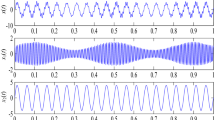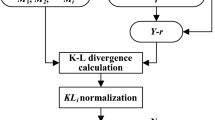Abstract
The mirror extension is a basic algorithm to treat the end effects in the empirical mode decomposition (EMD) of signals. It must meet the requirements of the specular position at the local extremum, but the actual signal is very difficult to implement. For this reason, its decomposition can lead to severe distortion. This paper proposed a new approach to the performance improvement of end effect elimination in EMD method through the data extension on the basis of traditional mirror extension technique coupled with the function regression method of support vector machine (SVM). Some data outside of both ends of an original signal are firstly predicted by means of the relationships obtained by the function regression method of SVM, from which one or more extreme points outside each end are captured. And then the mirror extension algorithm is used to inhibit the end effects possibly occurring in operation of EMD method. The application examples of the simulated signal show that the proposed method can effectively eliminate the end effect of the EMD method.










Similar content being viewed by others
References
Huang NE, Shen Z, Long SR, Wu MC, Shih HH, Zheng Q, Yen NC, Tung CC, Liu HH (1998) The empirical mode decomposition and the Hilbert spectrum for non-linear and non-stationary time series analysis. Proc R Soc Lond A 454(12):903–995
Yan J, Lu L (2014) Improved Hilbert–Huang transform based weak signal detection methodology and its application on incipient fault diagnosis and ECG signal analysis. Signal Process 98:74–87
Chu PC, Fan C, Huang N (2014) Derivative-optimized empirical mode decomposition for the Hilbert–Huang transform. J Comput Appl Math 259:57–64
Liu X, Bo L, Luo H (2015) Bearing faults diagnostics based on hybrid LS-SVM and EMD method. Measurement 59:145–166
Han J, Zheng P, Wang H (2014) Structural modal parameter identification and damage diagnosis based on Hilbert-Huang transform. Earthq Eng Eng Vib 13(1):101–111
An FP, Lin DC, Li YA, Zhou XW (2015) Edge effects of BEMD improved by expansion of support-vector-regression extrapolation and mirror-image signals. Opt Int J Light Electron Opt 126(21):2985–2993
He Z, Shen Y, Wang Q (2012) Boundary extension for Hilbert–Huang transform inspired by gray prediction model. Signal Process 92(3):685–697
Zhang M, Tang J, Zhang X, Zhang J (2016) Intelligent diagnosis of short hydraulic signal based on improved EEMD and SVM with few low-dimensional training samples. Chin J Mech Eng 29(2):396–405
He Z, Wang Q, Shen Y, Jin J, Wang Y (2013) Multivariate gray model-based BEMD for hyperspectral image classification. IEEE Trans Instrum Meas 62(5):889–904
Zhang Z, Gu L, Zhu Y (2013) Intelligent fault diagnosis of rotating machine based on SVMs and EMD method. Open Autom Control Syst J 5:219–230
Han KL, Thomas SVM, Koontz SM, Changpriroa CM, Ha SK, Malech HL, Kang EM (2013) Adenosine A2A receptor agonist–mediated increase in donor-derived regulatory T cells suppresses development of graft-versus-host disease. J Immunol 190(1):458–468
Rilling R, Flandrin P, Goncalvès P (2003) On empirical mode decomposition and its algorithms. In: IEEE-EURASIP workshop on nonlinear signal and image processing, Grado(I). pp 1–5
Lee YS, Tsakirtzis S, Vakakis AF, Bergman LA, McFarland DM (2009) Physics-based foundation for empirical mode decomposition. AIAA J 47(12):2938–2963
Mandic DP, ur Rehman N, Wu Z et al (2013) Empirical mode decomposition-based time-frequency analysis of multivariate signals: the power of adaptive data analysis. IEEE Signal Process Mag 30(6):74–86
Bin GF, Gao JJ, Li XJ, Dhillon BS (2012) Early fault diagnosis of rotating machinery based on wavelet packets—empirical mode decomposition feature extraction and neural network. Mech Syst Signal Process 27:696–711
Vapnik VN (1995) The nature of statistical learning theory. Springer-Verlag, NewYork
Qi Z, Tian Y, Shi Y (2013) Robust twin support vector machine for pattern classification. Pattern Recogn 46(1):305–316
Orrù G, Pettersson-Yeo W, Marquand AF, Sartori G, Mechelli A (2012) Using support vector machine to identify imaging biomarkers of neurological and psychiatric disease: a critical review. Neurosci Biobehav Rev 36(4):1140–1152
Yang JN, Lei Y, Lin S, Huang N (2004) Hilbert-Huang based approach for structural damage detection. ASCE J Eng Mech 130(1):85–95
Pradhan B (2013) A comparative study on the predictive ability of the decision tree, support vector machine and neuro-fuzzy models in landslide susceptibility mapping using GIS. Comput Geosci 51:350–365
Author information
Authors and Affiliations
Corresponding author
Additional information
Publisher’s Note
Springer Nature remains neutral with regard to jurisdictional claims in published maps and institutional affiliations.
Rights and permissions
About this article
Cite this article
Wang, J., Liu, W. & Zhang, S. An approach to eliminating end effects of EMD through mirror extension coupled with support vector machine method. Pers Ubiquit Comput 23, 443–452 (2019). https://doi.org/10.1007/s00779-018-01198-6
Received:
Accepted:
Published:
Issue Date:
DOI: https://doi.org/10.1007/s00779-018-01198-6




